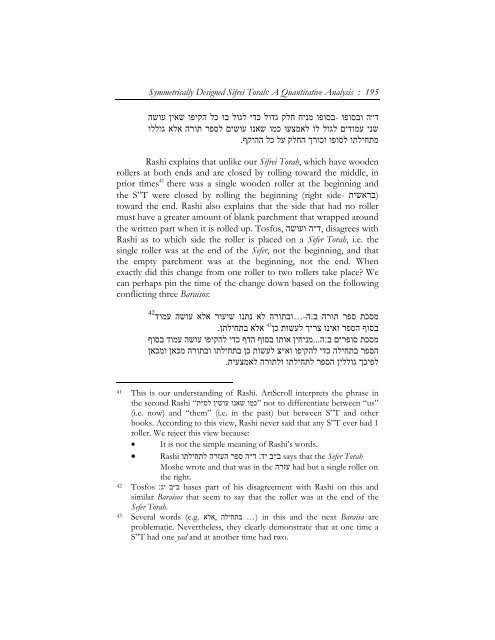Symmetrically Designed Sifrei Torah: A Quantitative Analysis - Hakirah
Symmetrically Designed Sifrei Torah: A Quantitative Analysis - Hakirah
Symmetrically Designed Sifrei Torah: A Quantitative Analysis - Hakirah
Create successful ePaper yourself
Turn your PDF publications into a flip-book with our unique Google optimized e-Paper software.
<strong>Symmetrically</strong> <strong>Designed</strong> <strong>Sifrei</strong> <strong>Torah</strong>: A <strong>Quantitative</strong> <strong>Analysis</strong> : 195<br />
ד״ה ובסופו -בסופו מניח חלק גדול כדי לגול בו כל הקיפו שאין עושה<br />
שני עמודים לגול לו לאמצעו כמו שאנו עושים לספר תורה אלא גוללו<br />
מתחילתו לסופו וכורך החלק על כל ההיקף.<br />
Rashi explains that unlike our <strong>Sifrei</strong> <strong>Torah</strong>, which have wooden<br />
rollers at both ends and are closed by rolling toward the middle, in<br />
prior times 41 there was a single wooden roller at the beginning and<br />
(בראשית side- the S”T were closed by rolling the beginning (right<br />
toward the end. Rashi also explains that the side that had no roller<br />
must have a greater amount of blank parchment that wrapped around<br />
the written part when it is rolled up. Tosfos, ועושה ,ד״ה disagrees with<br />
Rashi as to which side the roller is placed on a Sefer <strong>Torah</strong>, i.e. the<br />
single roller was at the end of the Sefer, not the beginning, and that<br />
the empty parchment was at the beginning, not the end. When<br />
exactly did this change from one roller to two rollers take place? We<br />
can perhaps pin the time of the change down based on the following<br />
conflicting three Baraisos:<br />
42<br />
מסכת ספר תורה ב׃ה-…ובתורה לא נתנו שיעור אלא עושה עמוד<br />
בסוף הספר ואינו צריך לעשות כן אלא בתחילתן.<br />
מסכת סופרים ב׃ה...מניחין אותו בסוף הדף כדי להקיפו עושה עמוד בסוף<br />
הספר בתחילה כדי להקיפו וא״צ לעשות כן בתחילתו ובתורה מכאן ומכאן<br />
לפיכך גוללין הספר לתחילתו ולתורה לאמצעית.<br />
43<br />
41 This is our understanding of Rashi. ArtScroll interprets the phrase in<br />
the second Rashi שאנו עושין לס״ת“ ”כמו not to differentiate between “us”<br />
(i.e. now) and “them” (i.e. in the past) but between S”T and other<br />
books. According to this view, Rashi never said that any S”T ever had 1<br />
roller. We reject this view because:<br />
• It is not the simple meaning of Rashi’s words.<br />
• Rashi ב״ב יד׃ ד״ה ספר העזרה לתחילתו says that the Sefer <strong>Torah</strong><br />
Moshe wrote and that was in the עזרה had but a single roller on<br />
the right.<br />
42 Tosfos ב״ב יג׃ bases part of his disagreement with Rashi on this and<br />
similar Baraisos that seem to say that the roller was at the end of the<br />
Sefer <strong>Torah</strong>.<br />
43 Several words (e.g. בתחילה ,אלא …) in this and the next Baraisa are<br />
problematic. Nevertheless, they clearly demonstrate that at one time a<br />
S”T had one yad and at another time had two.
















